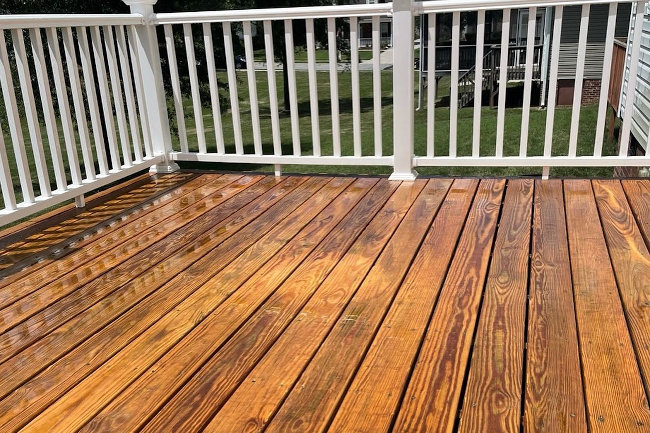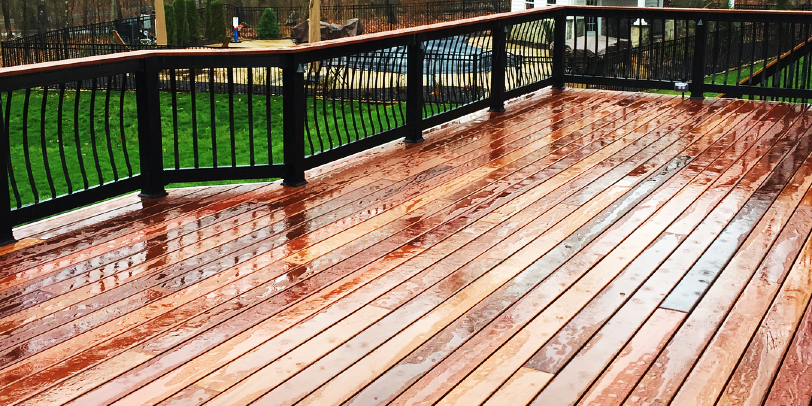Stain Deck Like a Pro: Crucial Steps for a Perfect End up
Stain Deck Like a Pro: Crucial Steps for a Perfect End up
Blog Article
A Comprehensive Guide to Different Sorts Of Deck Staining Techniques for Ultimate Defense and Aesthetic Appeals
In the realm of deck upkeep, the art of staining stands as a critical action in the direction of both maintaining the integrity of your outdoor area and boosting its aesthetic charm. As we navigate through the detailed globe of deck discoloration methods, one begins to value the nuanced techniques that can make all the distinction in between a sub-par coating and a perfect one.
Recognizing Different Kinds Of Stains
Different types of spots are commonly utilized in the procedure of deck staining to achieve different visual and protective effects. On the other hand, semi-transparent spots provide a balance between shade enhancement and protection, allowing some wood grain to reveal via.
Moreover, there are also specialized discolorations such as sealants and toners. Toners add a tip of color to the wood while providing minimal security, making them suitable for newer decks with much less wear. Sealants, on the other hand, offer protection versus moisture and UV rays without including color, making them a prominent option for decks that already boast a preferable hue. Recognizing the features and advantages of each sort of stain is essential for attaining the wanted appearance and resilience for your deck.
Selecting the Right Stain Shade
When considering the appearances of your deck discoloration task, the option of stain shade plays an essential role in enhancing the safety qualities of the picked tarnish kind (Beautiful Deck). The shade you choose can significantly affect the overall look of your deck, as well as its ability to endure the components with time
When choosing a stain color, it's necessary to consider the existing color pattern of your home's outside. Integrating the deck stain with the overall visual of your building can create a cohesive and visually appealing exterior area. Furthermore, the shade of your deck discolor can influence the temperature level of the deck surface; darker shades have a tendency to absorb more warmth, while lighter colors mirror sunshine and stay cooler.
Additionally, the sort of wood you are tarnishing will also affect how the stain shade appears. Various wood types can interact with the discolor in numerous methods, possibly altering the final color. It's advisable to test the tarnish on a small, unnoticeable area of the deck to make sure the color transforms out as preferred before waging the entire task.
Preparing Your Deck for Discoloration
To guarantee a effective and resilient deck discoloration job, comprehensive prep work of the deck surface area is crucial. Begin by cleaning up the deck completely to get rid of dust, grime, mold, and any old finish or discolor. Make use of a deck cleaner or a mixture of water and detergent along with a stiff brush or pressure washer to scrub the surface clean. After cleansing, enable the deck to dry completely prior to carrying on to the following step.
Inspect the deck for any type of harmed or rotten boards that require to be replaced. Hammer down a fantastic read any extending nails and sand any kind of harsh areas to make sure a smooth surface area for staining. Examine for any kind of loose barriers or steps that might need tightening up or repair service.
When the deck is tidy, completely dry, and in good repair work, consider applying a wood brightener to bring back the deck's natural color and open the timber pores for far better discolor infiltration. Safeguard any kind of close-by plants, furnishings, or surfaces with plastic sheeting before continuing with the staining procedure. Proper prep work is essential to achieving a professional-looking surface and optimizing the long life of your deck stain.
Using Discoloration With Numerous Techniques
For a remarkable and expert surface, the technique of applying discolor plays a critical function in boosting the appearance and toughness of your deck. There are a number of techniques you can utilize to guarantee an efficient application of stain.
It is optimal for intricate areas and getting to in between deck boards. Back-brushing after rolling is recommended to also out the tarnish and function it into the timber for far better infiltration.
Splashing is one more prominent technique, providing rate and ease of application, particularly for big deck areas. Whichever technique you pick, guaranteeing correct prep work and following manufacturer guidelines will aid attain a durable and attractive stain finish on your deck.

Maintaining and Re-staining Your Deck
When it comes to re-staining your deck, the regularity depends on various elements such as the kind of stain used, the environment in your location, and exactly how much wear and tear your deck experiences. Typically, it is recommended additional info to re-stain your deck every 2-4 years to keep its security and aesthetic appeals.
Before re-staining, guarantee the deck is clean, completely dry, and devoid of any type of previous stain residue. Fining sand may be required to smooth out harsh areas or eliminate old tarnish that is flaking. Choose a high-grade tarnish that fits your deck's product and offers the wanted level of defense. Apply the tarnish uniformly utilizing the suitable method talked my response about earlier in this guide to make certain a lasting and attractive finish - Chicago Deck Staining. By staying aggressive with maintenance and re-staining, you can take pleasure in a aesthetically enticing and well-protected deck for many years to come.
Final Thought
In verdict, recognizing the different kinds of deck stains, picking the ideal color, properly preparing the deck, using tarnish with various techniques, and re-staining the deck and maintaining are vital steps for best defense and looks. By following these actions, you can guarantee that your deck continues to be in leading problem for years ahead.
Additionally, the shade of your deck stain can affect the temperature level of the deck surface; darker shades have a tendency to absorb even more warmth, while lighter colors reflect sunlight and stay cooler.
It's a good idea to examine the discolor on a little, inconspicuous location of the deck to make sure the color turns out as wanted prior to proceeding with the entire task.

Report this page